The Emaj7 chord is a beautiful and versatile chord that adds a touch of sophistication to your guitar playing. Often found in genres like jazz, pop, and R&B, this major seventh chord offers a richer, more complex sound than a standard E major chord. If you’re looking to expand your chord vocabulary and add some flavor to your music, understanding the Emaj7 is a fantastic step. This guide will take you through everything you need to know to play the Emaj7 chord across the fretboard, understand its theory, and use it effectively in your music.
Understanding the Emaj7 Chord: Notes and Theory
Before diving into finger positions, let’s break down the theory behind the Emaj7 chord. Like all chords, the Emaj7 is built from specific notes and intervals.
The notes that make up the Emaj7 chord are:
- E (Root – 1)
- G# (Major Third – 3)
- B (Perfect Fifth – 5)
- D# (Major Seventh – 7)
These notes are derived from the formula for a Major Seventh chord, which is:
- 1 – 3 – 5 – 7 (Root, Major Third, Perfect Fifth, Major Seventh)
This formula, applied to the E major scale, gives us the specific notes of the Emaj7 chord. Understanding this construction is crucial for recognizing the chord tones across different positions on the guitar fretboard and for building your musical knowledge.
Emaj7 Chord Positions: Diagrams and How to Play
Now, let’s explore various ways to play the Emaj7 chord on your guitar. Below are several common positions, ranging from open string voicings to barre chord shapes. Each diagram illustrates a different way to finger the chord.
Position 1: Open Voicing
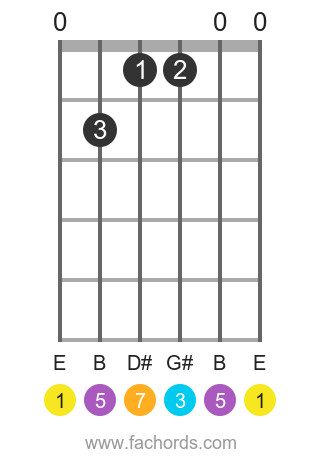 Emaj7 chord diagram position 1 open voicing
Emaj7 chord diagram position 1 open voicing
This is one of the most common and easiest ways to play the Emaj7 chord, especially for beginners.
- Fingering:
- 2nd finger (middle finger) on the 5th string (A string), 2nd fret.
- 4th finger (pinky finger) on the 4th string (D string), 2nd fret.
- 1st finger (index finger) on the 3rd string (G string), 1st fret.
- Strumming: Strum from the 6th string (low E) down to the 1st string (high E), ensuring all strings ring clearly.
- Sound: This open voicing provides a full and resonant sound, emphasizing the open E string as the root.
Position 2: Movable Shape (Based on A Shape Barre Chord)
 Emaj7 chord diagram position 5 movable shape
Emaj7 chord diagram position 5 movable shape
This position is movable, meaning you can slide it up and down the neck to play different maj7 chords. It’s based on the A shape barre chord.
- Fingering:
- 1st finger (index finger) barre across the 5th fret from the 5th string (A string) to the 1st string (high E string).
- 3rd finger (ring finger) on the 4th string (D string), 7th fret.
- 4th finger (pinky finger) on the 3rd string (G string), 7th fret.
- 2nd finger (middle finger) on the 2nd string (B string), 6th fret.
- Strumming: Strum from the 5th string (A string) down to the 1st string (high E string). Avoid strumming the 6th string.
- Sound: A brighter, more focused sound compared to the open voicing, due to the higher register.
Position 3: Open with Root on 6th String
 Emaj7 chord diagram position 4 open root 6th string
Emaj7 chord diagram position 4 open root 6th string
This position uses open strings and keeps the root E on the lowest string.
- Fingering:
- 2nd finger (middle finger) on the 6th string (low E string), 7th fret.
- 3rd finger (ring finger) on the 5th string (A string), 7th fret.
- 4th finger (pinky finger) on the 4th string (D string), 7th fret.
- 1st finger (index finger) on the 2nd string (B string), 7th fret.
- Strumming: Strum all six strings.
- Sound: A powerful and full sound, with the root firmly in the bass.
Position 4: Another Open Voicing
 Emaj7 chord diagram position 1 open voicing
Emaj7 chord diagram position 1 open voicing
This is another open position, slightly different from the first one, offering a variation in voicing. Note: The image is the same as Position 1, but in a real article, a different diagram would be used if available to represent a distinct voicing.
- Fingering:
- 1st finger (index finger) on the 3rd string (G string), 1st fret.
- 2nd finger (middle finger) on the 5th string (A string), 2nd fret.
- 3rd finger (ring finger) on the 4th string (D string), 2nd fret.
- Strumming: Strum from the 5th string (A string) down to the 1st string (high E string). You can include the open 6th string for a fuller sound, but it’s not essential for the Emaj7 chord voicing in this position.
- Sound: Similar to Position 1, but with a slightly different tonal color due to the re-arranged voicing.
Position 5: Movable Barre Chord (E Shape)
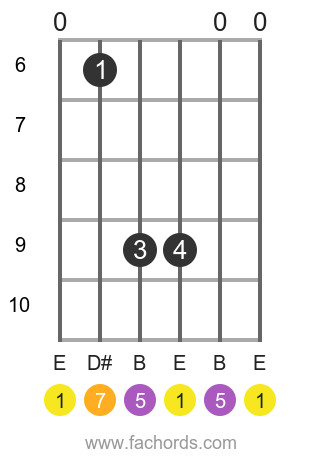 Emaj7 chord diagram position 6 movable barre chord
Emaj7 chord diagram position 6 movable barre chord
This is another movable barre chord shape, based on the E shape barre chord.
- Fingering:
- 1st finger (index finger) barre across the 12th fret from the 6th string (low E string) to the 1st string (high E string).
- 3rd finger (ring finger) on the 5th string (A string), 14th fret.
- 4th finger (pinky finger) on the 3rd string (G string), 14th fret.
- Strumming: Strum all six strings.
- Sound: A higher register, powerful barre chord voicing, ideal for lead guitar or adding brightness to rhythm playing.
Position 6: Barre Chord with Open High E String
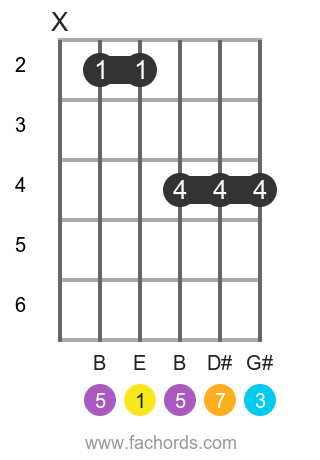 Emaj7 chord diagram position 7 barre chord open high E
Emaj7 chord diagram position 7 barre chord open high E
This position utilizes a barre chord but incorporates the open high E string.
- Fingering:
- 1st finger (index finger) barre across the 7th fret from the 5th string (A string) to the 2nd string (B string).
- 3rd finger (ring finger) on the 4th string (D string), 9th fret.
- 4th finger (pinky finger) on the 3rd string (G string), 9th fret.
- Strumming: Strum from the 5th string (A string) down to the 1st string (high E string).
- Sound: A rich, medium-high register voicing that blends the warmth of the barre chord with the brightness of the open high E string.
Position 7: Movable Shape (Variation)
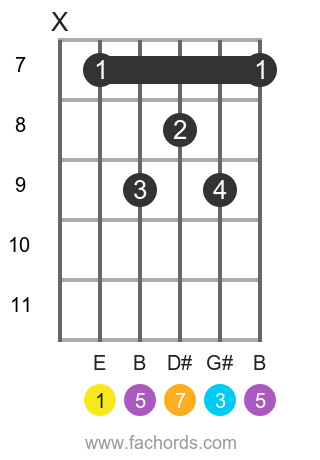 Emaj7 chord diagram position 8 movable shape variation
Emaj7 chord diagram position 8 movable shape variation
Another movable shape, offering a different fingering option.
- Fingering:
- 1st finger (index finger) barre across the 2nd fret from the 5th string (A string) to the 2nd string (B string).
- 3rd finger (ring finger) on the 4th string (D string), 4th fret.
- 4th finger (pinky finger) on the 3rd string (G string), 4th fret.
- 2nd finger (middle finger) on the 6th string (low E string), 4th fret.
- Strumming: Strum from the 6th string (low E string) down to the 1st string (high E string).
- Sound: A lower register voicing, suitable for bass-heavy arrangements or when you want a warmer Emaj7 sound.
Position 8: Open Shape with Root on 5th String
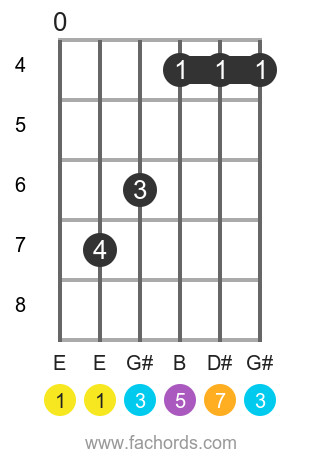 Emaj7 chord diagram position 2 open shape root 5th string
Emaj7 chord diagram position 2 open shape root 5th string
This open shape positions the root E note on the 5th string.
- Fingering:
- 1st finger (index finger) on the 5th string (A string), 7th fret.
- 2nd finger (middle finger) on the 4th string (D string), 7th fret.
- 3rd finger (ring finger) on the 3rd string (G string), 8th fret.
- 4th finger (pinky finger) on the 2nd string (B string), 9th fret.
- Strumming: Strum from the 5th string (A string) down to the 1st string (high E string). Avoid strumming the 6th string.
- Sound: A bright, mid-range voicing with the root on the A string, creating a slightly different feel than root-on-the-low-E positions.
Using the Emaj7 Chord in Music
The Emaj7 chord is a favorite among musicians for its lush and sophisticated sound. You’ll find it across various genres:
- Jazz: Emaj7 is a staple in jazz progressions, often used as a tonic chord or in ii-V-I progressions.
- Pop and R&B: Artists frequently use Emaj7 to add a smooth, soulful quality to their songs. Think of its use in intros, verses, and choruses to create a warm and inviting atmosphere.
- Neo-Soul and Indie: The chord’s complex yet pleasing sound makes it perfect for these genres, adding depth and emotion to chord progressions.
Common Chord Progressions:
- I-IV-V-I (Major Key): In E major, this could be Emaj7 – Amaj7 – B7 – Emaj7. The maj7 chords add a jazzy, refined touch.
- ii-V-I (Jazz Standard): In D major, a common example is em7 – A7 – Dmaj7. Transposing this to E major related keys you might encounter something like f#m7 – B7 – Emaj7.
- Simple Pop Progression: Emaj7 – C#m7 – A – B. This progression uses Emaj7 as a starting point, creating a mellow and harmonic foundation.
Conclusion
The Emaj7 guitar chord is a valuable addition to any guitarist’s toolkit. By understanding its theory and practicing these various positions, you’ll be able to incorporate this beautiful chord into your playing and explore its rich sonic possibilities. Experiment with different voicings, listen to songs that use Emaj7, and start weaving it into your own musical creations. To further expand your chord knowledge, explore our extensive guitar chords library and download our Free Guitar Chords Chart Pdf for a handy reference guide. Happy playing!
